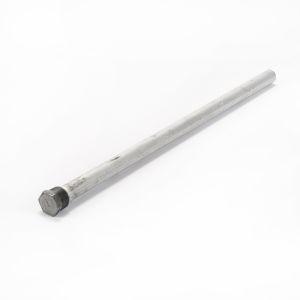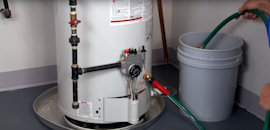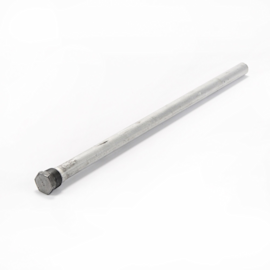- Kenmore refrigerator water filters
- Whirlpool refrigerator water filters
- Samsung refrigerator water filters
- GE refrigerator water filters
- LG refrigerator water filters
- Frigidaire refrigerator water filters
- KitchenAid refrigerator water filters
- Maytag refrigerator water filters
- Kenmore Elite refrigerator water filters
- Estate refrigerator water filters
- GE Profile refrigerator water filters
- Amana refrigerator water filters
- Bosch refrigerator water filters
- Dacor refrigerator water filters
- Electrolux refrigerator water filters
Water heater common questions


These common questions about water heaters are the ones our experts hear the most often from our customers. You might also find the help you need by checking the common symptoms and solutions for water heaters. When you’re ready to make a repair, search your model number to find replacement parts. Sears PartsDirect has the part you need, no matter where you bought your water heater.
Why does my hot water smell like rotten eggs?
The anode rod in your water heater helps prevent tank corrosion. Certain water conditions cause a chemical reaction between the anode rod and supply water, which forms hydrogen sulfide gas that dissolves in the tank water. The hydrogen sulfide gas emerges from the water when you run the hot tap causing a “rotten egg smell.” Installing a less reactive aluminum alloy anode rod and chlorinating the water supply system eliminates the rotten-egg smell in hot water.
How do I flush sediment from my water heater tank?
Disconnect electrical power and shut off the water supply going to the water heater. Shut off the gas supply if you use a gas water heater. Connect a garden hose to the drain valve to route the drain water to the outside of your home. Open the drain valve and completely drain the tank. The sediment flushes out with the drain water.
To drain an electric water heater, open the water supply valve and refill the tank before restoring power to avoid damaging the heating elements. Restore power to the water heater. Open the gas supply valve for a gas water heater.
What size water heater do I need?
A family of 4 needs a 40- or 50-gallon water heater. Even using this size, a family of 4 may occasionally empty the tank and have to wait for it to recover. A household of 1 or 2 may be able to use a 30-gallon water heater. Larger families of 5 or more typically need an 80-gallon water heater.
What is FVIR?
It means Flammable Vapor Ignition Resistant. An ANSI (American National Standards Institute) standard went into effect in July 2003 in an effort to prevent a gas water heater from igniting flammable vapors outside the combustion chamber. This significantly reduces the danger of gas water heaters causing a spontaneous combustion when it's located in areas where other combustibles such as gasoline or propane are stored. Due to this change, new water heaters are significantly safer than water heaters manufactured before 2003.
What is thermal expansion?
As water is heated, it expands (thermal expansion). In a closed system, the volume of water will increase. As the volume of water increases, there will be a corresponding increase in water pressure due to thermal expansion. Thermal expansion can cause premature tank failure (leakage) in the water heater as well as damage plumbing fixtures and other appliances. Thermal expansion can also cause the temperature-pressure relief valve to open and discharge water due to excessive pressure buildup.
The temperature pressure relief valve is not intended for the constant relief of thermal expansion. A properly sized thermal expansion tank should be installed on all closed systems to control the harmful effects of thermal expansion.
What is a thermal expansion tank and do I need one?
A thermal expansion tank is a pressurized tank that sits on your cold line–typically near or on your water heater. The tank contains a pressurized bladder. As water expands, it pushes against this bladder giving the increased volume a place to go, preventing rapid pressure increases due to thermal expansion.
All major water heater manufacturers currently recommend expansion tanks. In fact, expansion tanks are required by state code in most states if you have a closed system. A closed system means when water is heated and expands, this increased volume has nowhere to go. Local enforcement of this code varies from city to city.
Thermal expansion tanks are available from Sears stores and through the Sears Service Centers. Contact the local plumbing inspector, water supplier and/or the Sears Service Center regarding the installation of a thermal expansion tank.
I have no hot water, what can I do?
Electric water heaters will have two circuit breakers dedicated for the water heater. Locate the two circuit breakers dedicated for the water heater and reset both circuit breakers. Flip both breakers OFF and back ON. Wait a few minutes to see if it begins to heat. If it does not heat water after resetting the circuit breakers, the high limit shut off system may have tripped. Electric water heaters have a high limit shut off system with a reset button located on the upper thermostat.
To reset the switch, turn the two circuit breakers to OFF. Remove the screw securing the cover and then remove the cover. Lift the insulation up to expose the RED reset button. Reset the high limit by pushing the RED button marked "RESET." Fold the insulation back over the thermostat and element and reinstall the cover and screw. Turn the two circuit breakers ON. If the high limit continues to trip the water heater off, this could indicate a defective thermostat or broken and shorted heating element. If it's a gas water heater, relight the pilot system. Follow the owner's manual for lighting instructions.
How do I adjust the water temperature?
The thermostat has been factory set at a setting which approximates 120°F (49°C), to reduce the risk of scald injury. The thermostats are adjustable if a different water temperature is desired. Turn OFF the electric power to the water heater and then remove the upper and lower access panels. Fold the insulation back to expose the thermostats. Turn the dial clockwise with a screwdriver to increase the temperature setting or counterclockwise to decrease the temperature setting. Replace the insulation and access panels. Turn ON the power supply. Read all warnings in your manual and on the water heater before proceeding.
Why is water coming from the pipe connected to the Temperature/Pressure relief valve?
The temperature/pressure relief valve is a safety device to release pressure within the water heater tank. If the temperature/pressure (T&P) relief valve on the water heater leaks or discharges hot water periodically, this may be due to thermal expansion, or a sign of overheating that can be caused by a defective thermostat or a broken and shorted heating element. The T&P relief valve must be manually operated and tested at least once a year. Caution should be taken to make sure that no one is in front of or around the outlet of the T&P relief valve discharge line because the water may be extremely hot. If the T&P relief valve continues to leak water after testing, shut off the power, drain the tank and replace the valve. Refill the tank before restoring power.
Do I need an insulation blanket around my water heater?
Homeowners and installers used to put blankets on water heaters to provide an extra layer of insulation, allowing the water heater to retain heat and operate more efficiently. These days, manufacturers are building extra insulation into the tank itself, so in most cases, insulation blankets are no longer needed.
Why does my water heater make a rumbling or loud bang noise sometimes?
What you’re hearing is a result of thermal expansion during the heating process. When sediment accumulates and settles at the bottom of your tank, heat cannot transfer to the water efficiently. These sounds shouldn’t cause immediate concern, but it does mean that the water heater is probably working harder than it should, which could shorten the life of the tank, and will definitely lead to a less efficient transfer of heat and higher operating costs. Turn off the water heater and drain the tank of sediment following the instructions in your owner's manual. Refill the tank with water before restoring power or before relighting a gas water heater.
I went to replace my old water heater and found that the new ones are all bigger. Why is this?
Water heaters made after April 16, 2015, must comply with the Department of Energy (DOE) efficiency standards. To meet these standards, the new tanks will be 2-8 inches taller and about 2-3 inches wider because of additional insulation required. If you have a tight water heater closet or a small door, you may have to relocate your water heater, modify the closet and/or have to take off the door jambs to fit the water heater through the door opening.
Most common symptoms to help you fix your water heaters
Choose a symptom to see related water heater repairs.
Main causes: lack of power, no gas supply, thermostat limit switch tripped, bad element, bad thermostat, gas valve failu…
Main causes: loose water pipe fittings, leaky drain valve, bad temperature-pressure relief valve, leaky heating element,…
Main causes: water supply needs chlorine treatment, anode rod too reactive…
Main causes: broken heating element, thermostat failure, excessive tank sediment, tank size too small, burner valve asse…
Main causes: faulty pressure relief valve, water is overheating…
Main causes: thermostats need adjustment, water heater capacity too low, bad heating element, thermostat failure, excess…
Main causes: thermostat temperature set too high, thermostats need adjustment, faulty thermostat, shorted heating elemen…
Most common repair guides to help fix your water heaters
Effective articles & videos to help repair your water heaters
Use the advice and tips in these articles and videos to get the most out of your water heater.

Learn how to decipher symbols so you can buy the right part for your problem.…

Read about some water heater repairs that you can easily do yourself.…

These common questions and answers can help you make the most of your water heater.…
